Many textile artists actively celebrate the history of damaged and abandoned materials by re-using them inventively, creating beauty from discarded debris and waste. Society is now waking up to the problems of consumerism and waste. If you, too, are looking for ways to recycle found materials and incorporate them into your work, then you are in the right place.
Clarissa Callesen is known for her textural sculptures and installations made with found objects and recycled materials. Her creations are visually stimulating, with the appearance of a fermenting, growing mass of textile-covered, stitched and wrapped shapes. She uses non-traditional materials that she has collected, including stones, rope, fabric, wood, wire, leather and even bullet casings. These materials inspire the direction of Clarissa’s work in which she explores the margins of life, finding beauty and value in items that society has discarded.
Clarissa exhibits her work throughout the US, including at the Museum of Northwest Art. She has held solo exhibitions in Seattle and Bellingham, in Washington State and Boise, Idaho. She has been an artist in residence at the Playa Artist Program in Summer Lake, Oregon, at Brush Creek Foundation in Saratoga, Wyoming, and also at Surel’s Place in Boise, Idaho. Her work has been featured in the books “Who’s your Dada?” and “Art without Waste”.
Teaching nationally and internationally, Clarissa has been sharing her passion for creativity over the last ten years, teaching her students to enjoy their work, embrace spontaneity and cherish their “mistakes”, all the while challenging them to be creative and innovative.
In this interview you’ll be captivated by the textural detail of Clarissa’s work. Discover how she ‘grows’ her textile sculptures by assembling bulbous fabric shape and layers of textiles, then stitching and wrapping to interconnect them, and trapping found objects within.

Textiles tell stories
TextileArtist.org: What initially attracted you to textiles as a medium? How was your imagination captured?
I am especially drawn to materials that carry the marks and energy of life and time, using objects that have already had a life before they reach my hands.
Through collecting discarded objects for my assemblage work, I started finding myself more and more drawn to textiles. Without knowing what I would do with them, I started amassing a sizeable collection of discarded clothing and domestic fabrics. Fabric has such an intimate connection with the human existence; from the completely mundane daily socks to the treasured silk wedding dress worn just once. I fell in love with the history and stories contained in recycled textiles.
The other constant in my work is texture. I love marks and scuffs, scratches and peeling paint, tatters and holes, smooth and patinated layers. Fabric is the queen of texture, exhibiting unlimited possibilities for texture, finish and opacity.
I worked with clay for many years and one of the amazing attributes of clay is its ability to imitate other materials, like rock, paper or cloth. The more I worked with textiles the more I realised it has the same capacity to impersonate other materials. I don’t think I’ll ever be beholden to a single medium, but textiles have definitely won my heart.
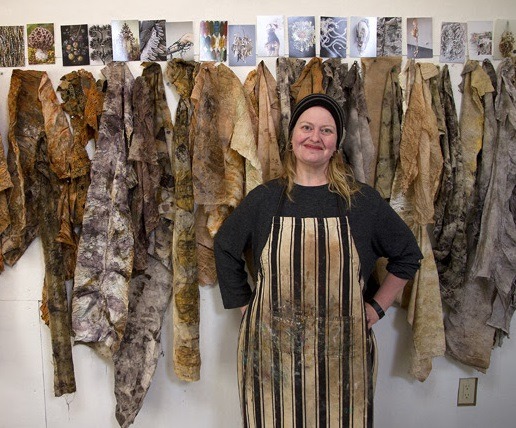
What or who were your early influences and how has your life/upbringing influenced your work?
Creativity did not play much of a role in my youth. I was too busy studying for top grades and doing my best to look and act “right”. I didn’t have time for painting or sewing, activities I considered as frivolous.
When I started college, my illusionary bubble of the perfect life burst. It was a messy and difficult time. One day I wandered into the art department. I met an amazing woman, an art instructor. She introduced me to strong feminist women making art, like Judy Chicago, Ana Mendieta, Carolee Schneemann, Cindy Sherman, Jenny Holtzer, and many more. They showed me that there was a place for the messy and the raw, and that art didn’t always have to be pretty.
Their bravery and power inspired me to find the knowledge that within myself I possess all I need to create an authentic creative life. I am forever grateful to that instructor and to all the women artists that bravely created art, no matter what.
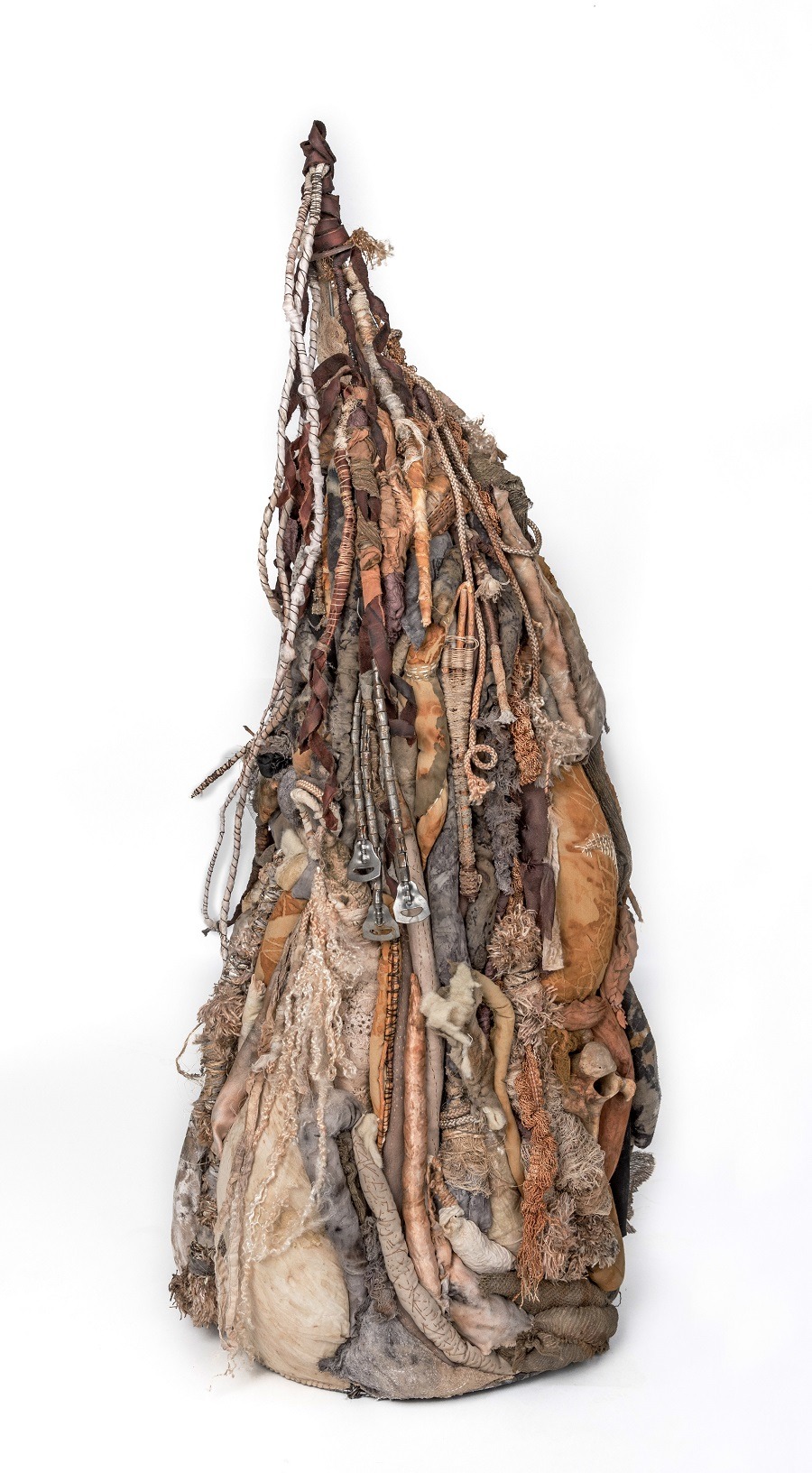
What was your route to becoming an artist?
Art has supported and nurtured me for my entire adult life. It has also been a wild ride with many paths travelled. I have made art with clay, paint, skin, fabric, plants, garbage, and even horse dung! I have sold my art on the streets and displayed it in museums.
I started my art career as a tattoo artist and when that became hard on my soul I traded my tattoo machine in for a pottery wheel and life as a functional potter. From there I fell in love with found objects and expanded my pottery to include assemblage. From the assemblage objects, textiles crept into my heart.
Sharing information and ideas has always just been a part of my way of being, so I don’t even know when teaching became a part of my artistic journey. It’s always been there in one form or another.
The most important part of my route to becoming an artist is always making art, no matter what.
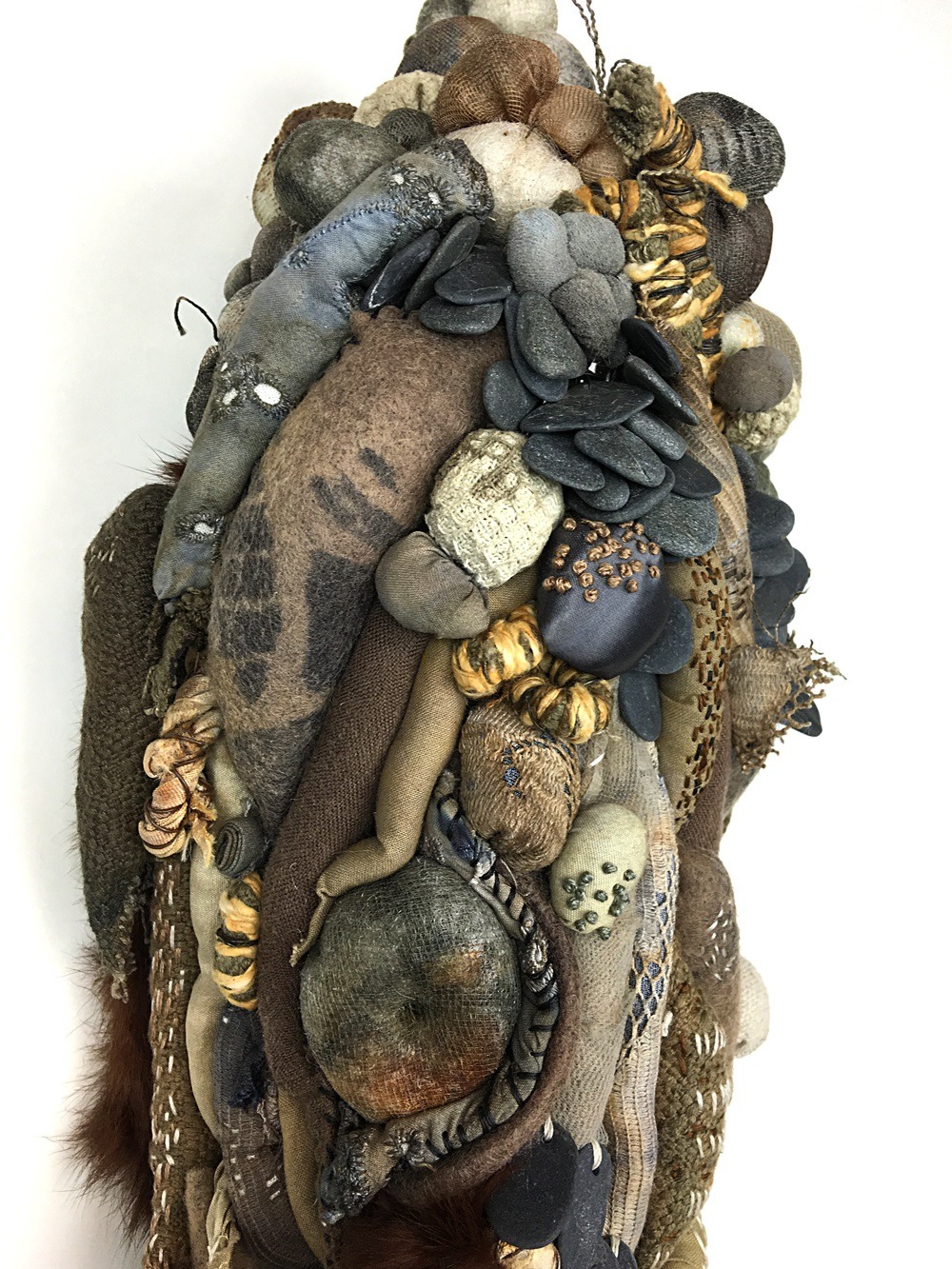
Intuitive assemblage
Tell us about your process from conception to creation
My process is strongly based on my materials. I tend to start by collecting fabric and objects intuitively, influenced by colour and texture.
I worked as an assemblage artist for years so my tendency is to create lots of components to work from. Then I arrange and edit, putting the pieces together like a puzzle. As I assemble the pieces it then becomes clear if I need more items of a particular colour or shape.
I usually have some emotional or intellectual connection with the materials as I choose them, but the deeper meaning or narrative develops as the piece evolves.
I work spontaneously without sketching or planning, but as my work is getting larger in scale I am finding myself doing more drawing. So that may be a shifting component. I like to let my process evolve and change with each new project.
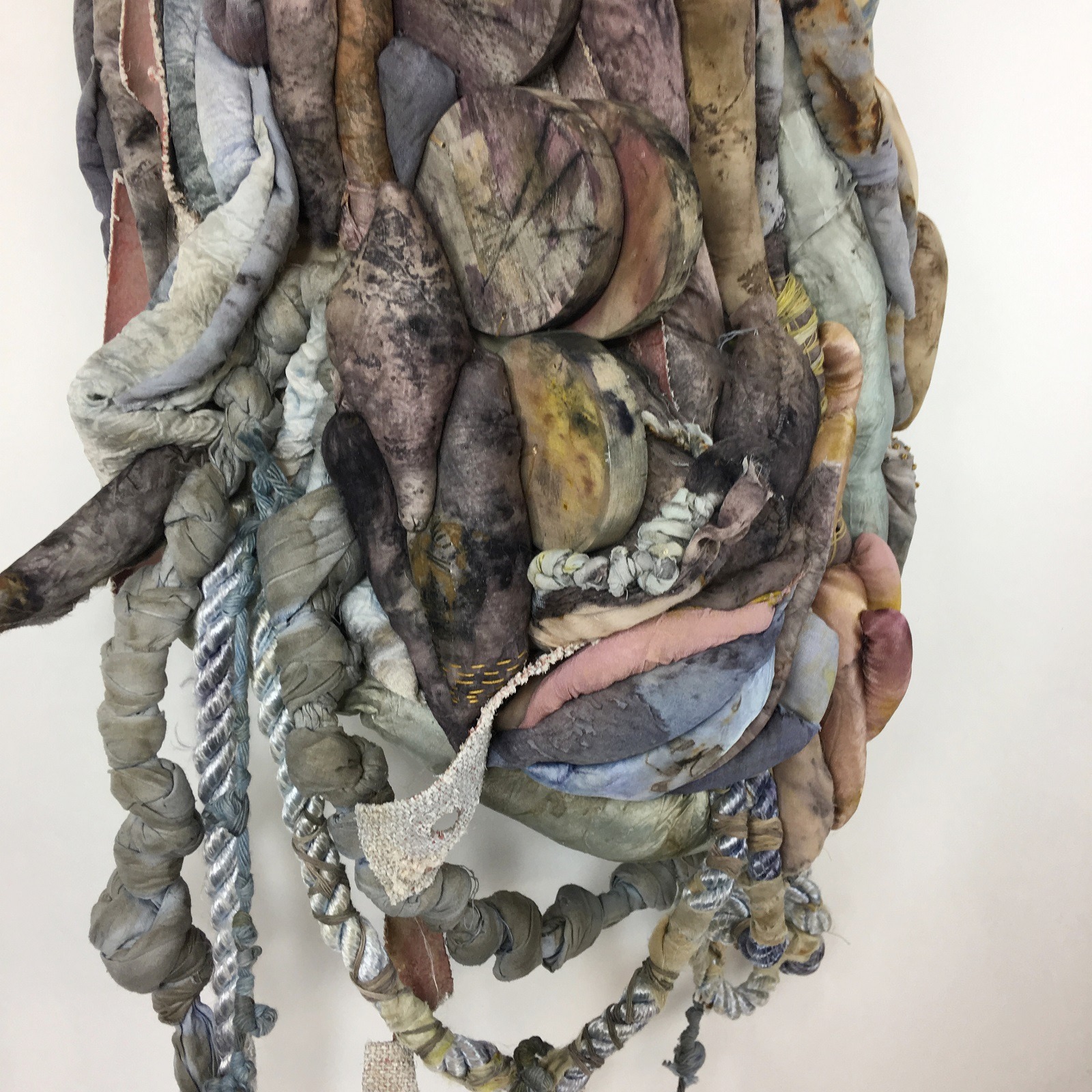
Tell us a bit about your chosen techniques and how you use them
My techniques are mostly self-taught. I come to the fiber art world through sculpture, so my techniques tend to be a bit unconventional! My approach is to have a go and see if it works. If not, then I’ll try adding a bit of wire or fire!
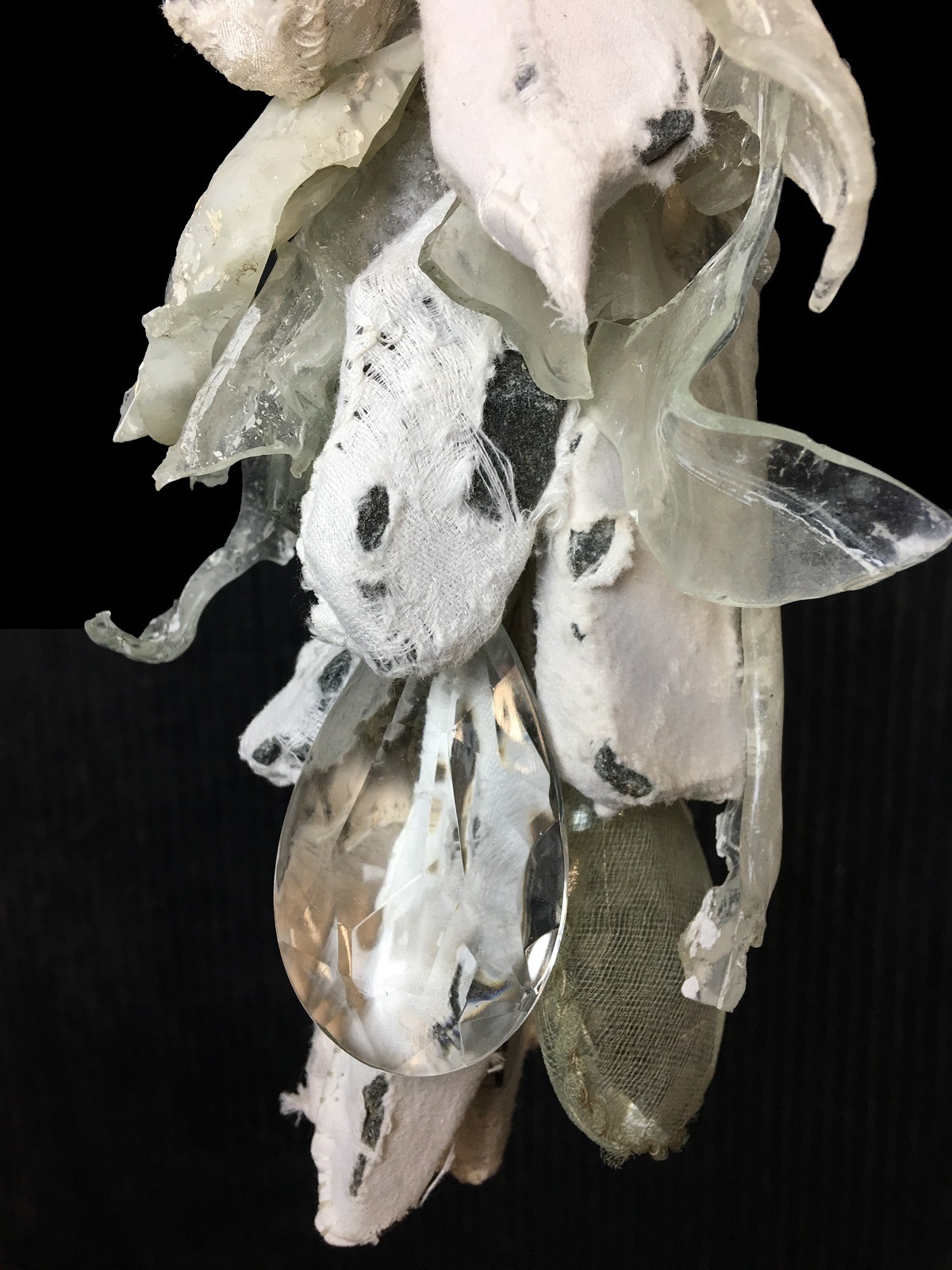
What currently inspires you?
The theme I have been working with a lot lately is how everyday objects and mundane activities create an often-overlooked connection between human beings.
All human life is connected through textiles. Almost everyone sleeps each night on soft fabric sheets or blankets. How many of us consider that universal commonality as we tuck ourselves into bed? How many women through time have worn a bridal gown? These concepts and materials directly inspire and influence my current work.
There are so many amazing textile artists worldwide, and we now have access to those artists in mere seconds with the touch of a keyboard. The amount of information and inspiration we have at our fingertips is truly unfathomable.
I am inspired by artists that approach textile art in a sculptural or non-traditional manner. For example, El Anatsui is a Ghanaian artist creating tapestries from waste aluminium bottle tops. Judith Scott, a visionary artist with Down’s syndrome, created exquisite sculptures encasing ordinary objects by wrapped them with string and yarn. Elisabeth Higgins O’Connor creates larger-than-life anthropomorphic forms out of discarded clothing and blankets.
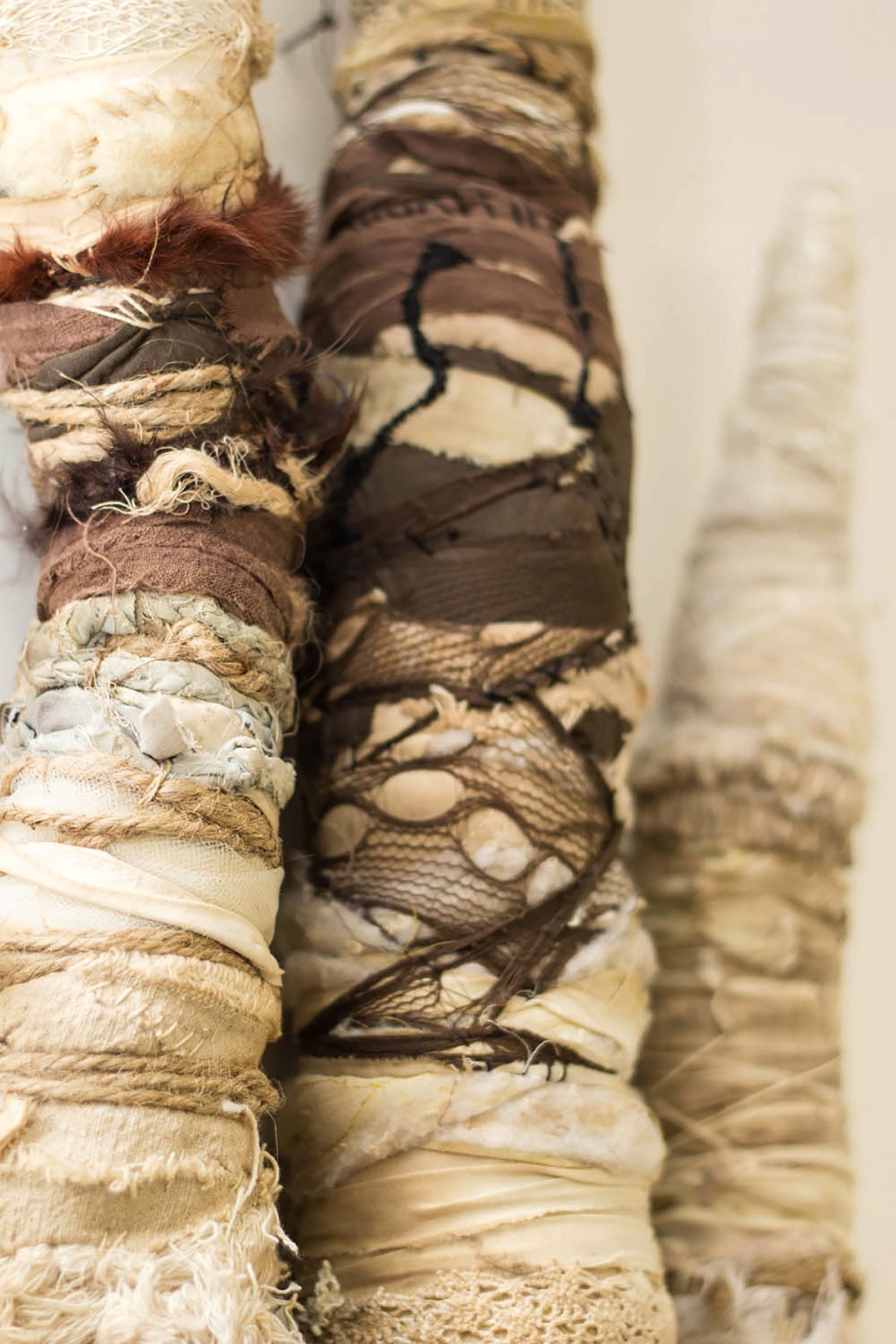
Stitching and wrapping to soothe
Tell us about a piece of your work that holds particularly fond memories and why?
One of my first textile sculptures was made during a very rough period of time in my life. I work with the challenge of depression in my life. I had an intense exacerbation lasting almost six months, where I moved very little from my couch. Time becomes very strange and amorphous during a long period of depression.
I started to stitch and wrap unconsciously as a way to soothe myself and reconcile the strange space I was living in. I created three large branch-like forms covered with layers of wrapped fabric, with stitches upon stitches upon stitches. I named them “Liminals” in honour of the strange liminal space they were created in. They now hang in my bedroom, reminding me of the resilience and fragility of the human experience.
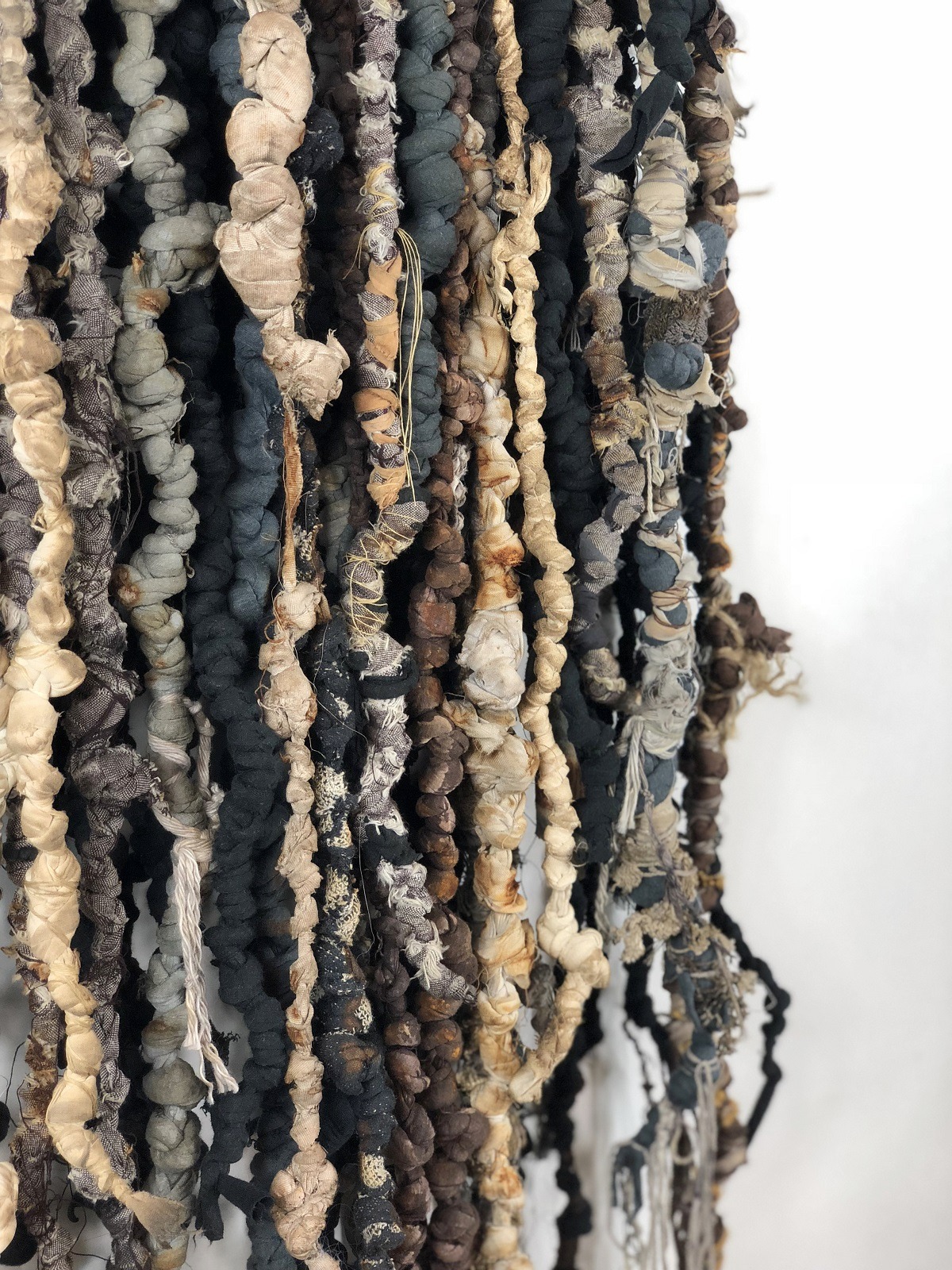
How has your work developed since you began and how do you see it evolving in the future?
Besides the many, varied evolutions through all my art media, about four years ago my work took a significant turn from figurative to almost completely abstract. I wanted to find ways to communicate larger ideas and feelings without containing them in literal forms.
Most recently I have been experimenting with ways for art to come away from the gallery walls. I want the work to encompass and interact with the viewer. Through this quest I have found my way into installation art and creating an entire environment to experience. I am currently working on a large-scale, community-based installation that connects people through common materials and simple actions.
Where next? Perhaps outdoor installations, impermanent art or experimental video? Or crochet?
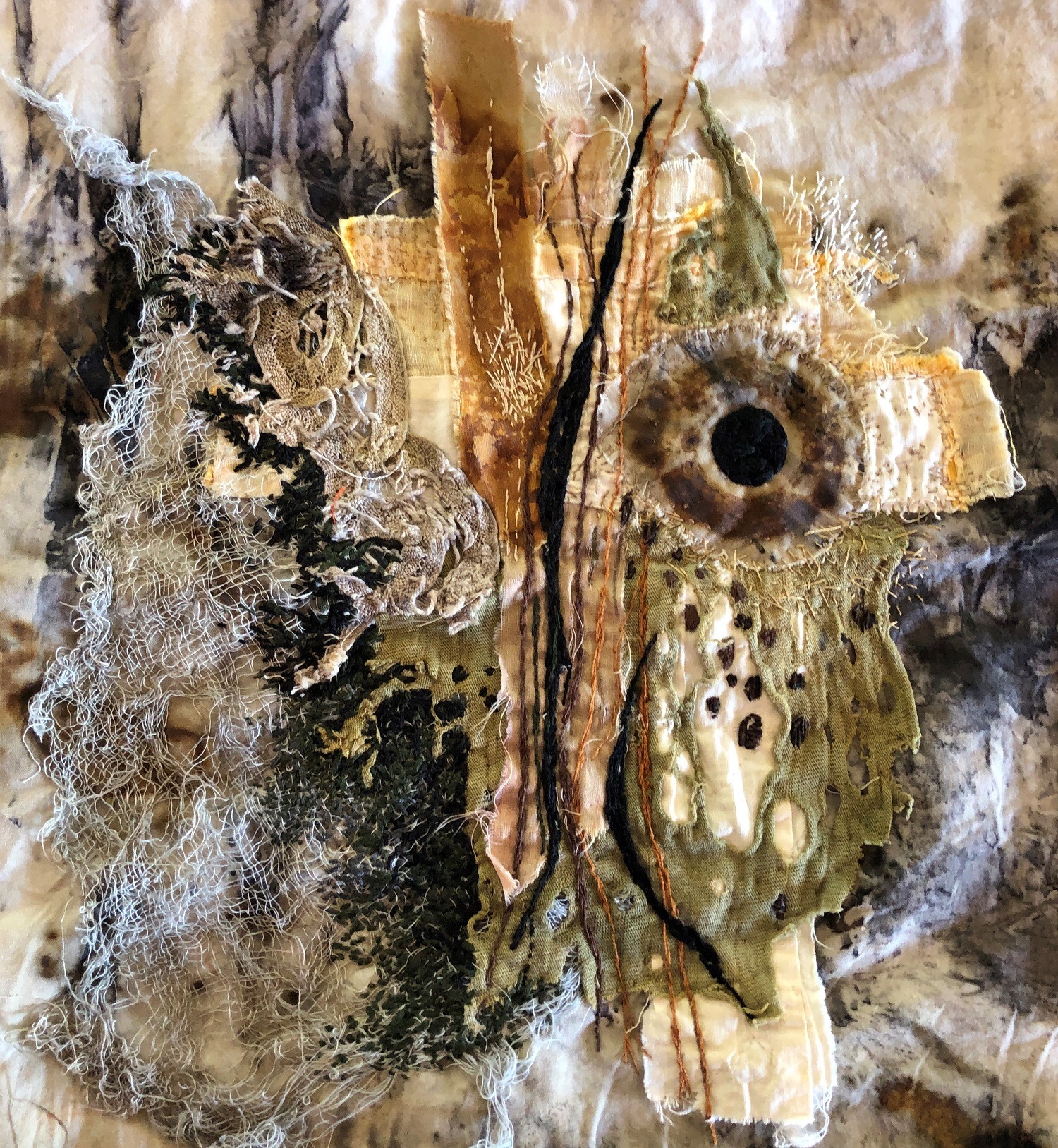
What advice would you give to an aspiring textile artist?
Don’t let the traditions of textile arts limit your exploration. Look to other art media for inspiration and to discover potential techniques.
Do your work! Make lots of art. Let it be bad or good, just keep creating.
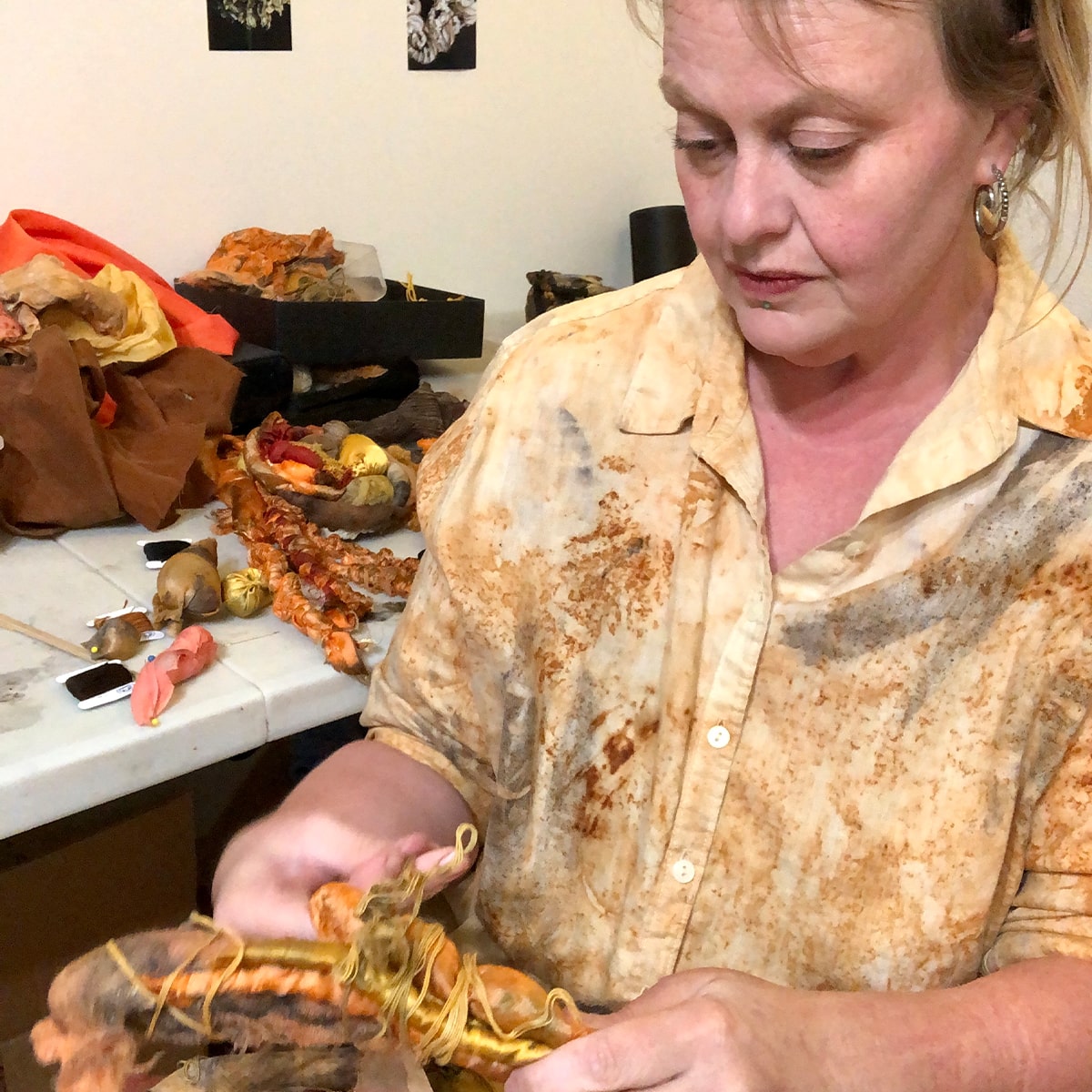
For more information visit www.clarissacallesen.com
Do you re-use old, discarded materials in your textile art? Tell us how, by leaving a comment below.
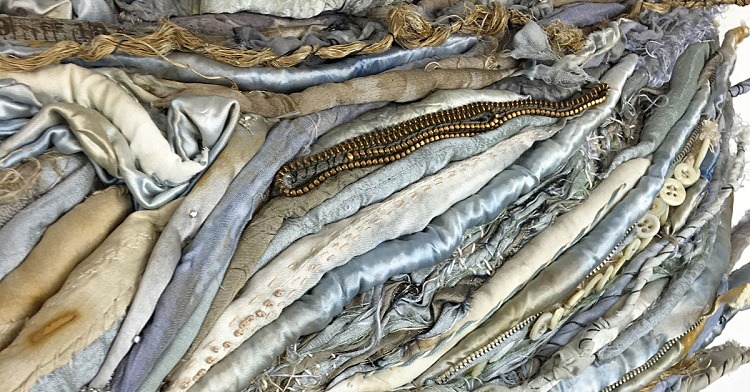

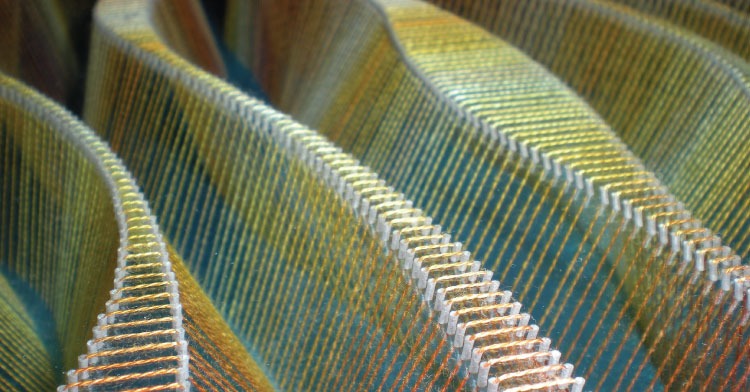
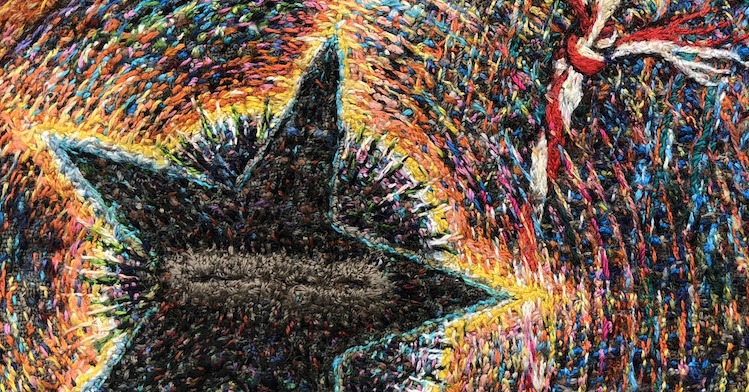
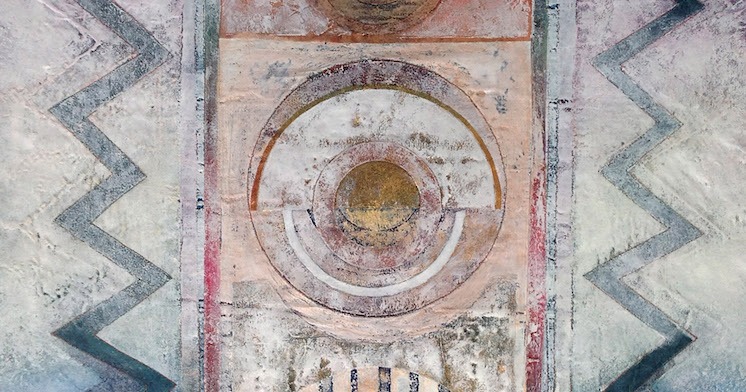
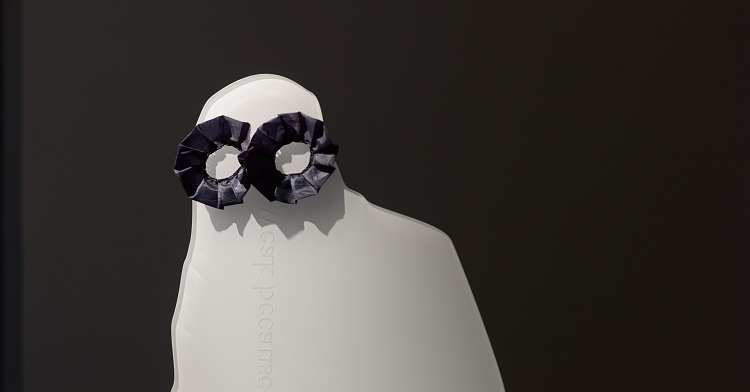
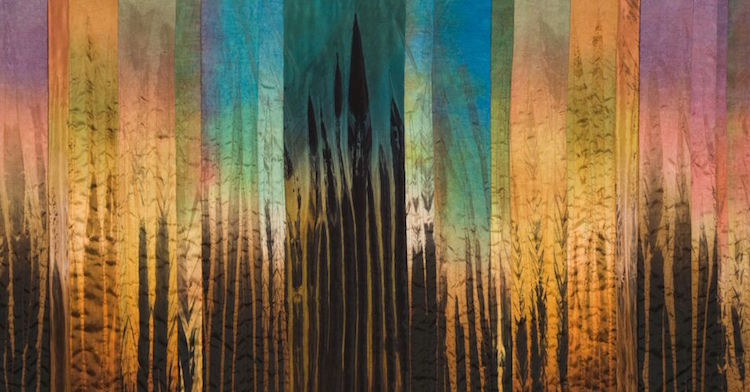
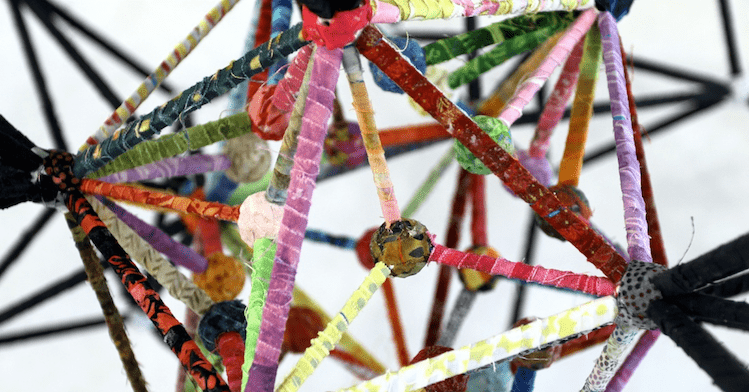
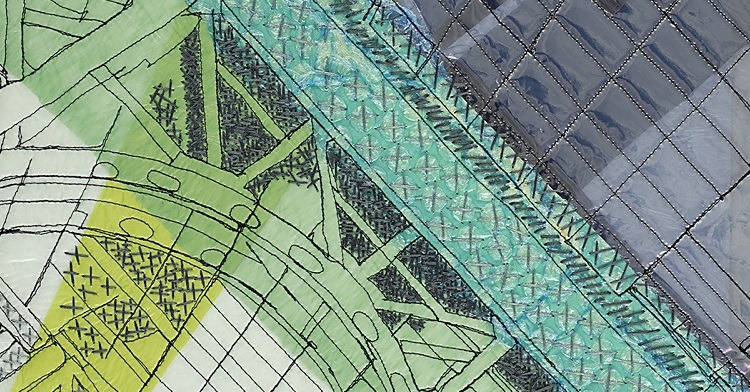
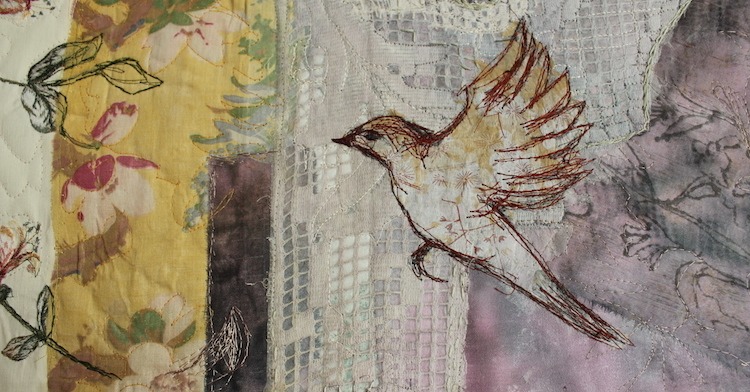
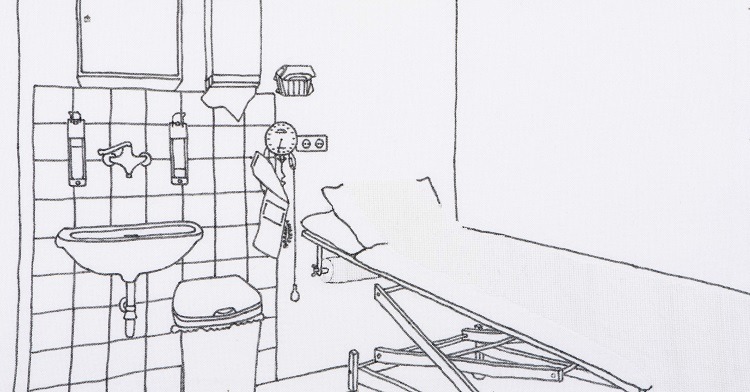
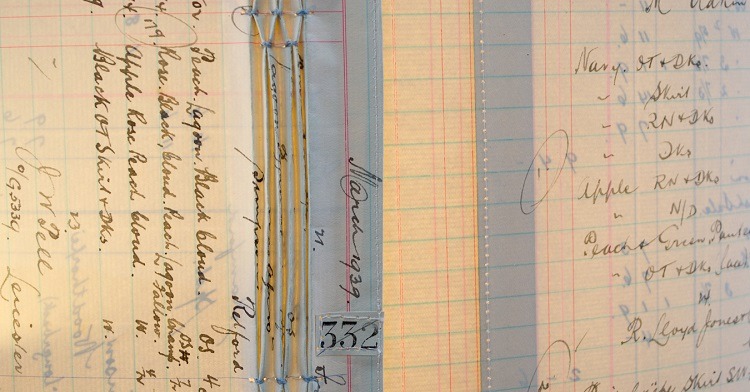
18 comments
alison schwabe
In the first W/S you did for StitchClub I was very inspired and remembered the stuffed suffolk puffs – which I’m currently exploring and frankly getting a bit carried away with. An embroidry turned qultmaker turned fibreartist, I often think of that inspiring W/S. My latest is on @schwabealison. Cheers!
Siân Goff
Thanks so much for your comment, Alison. It’s so great to hear how much you enjoyed Clarissa’s workshop and found it memorable. Best, Siân
Ida
Ik heb nog 4 zakken kleding van mijn dochter Larissa die op 39 jarige leeftijd is overleden. Ik wil daar graag een werkstuk van maken.
Dianne Carney
Hello to all readers of Clarissa Callesen and especially you Clarissa. I too have depression and your work Clarissa caught my attention and it gave me hope of my interest in creating from feelings, seeing, touching and smelling of textiles especially discarded unwanted items that I don’t want to throw away if I think it can be made into a beautiful piece of art or something so unique that it tells a story of its history. My son gave me flowers for valentines during covid 2020, they were so beautiful and as I watch them loose their youth, I kept telling myself I can’t throw them out. They are on my wall in wilted beauty and are happy to express their story each time I look at them. I’m so please with your life of creativity you are surely a credit to all of us and I appreciate your story. I wish I could enclosed a picture of the flowers so you all could see. I’ll wait and try to find a way. Have a superific day!
DC
Their
Melanie Dossey
I also am one of those people who want to recycle everything, but wondering how my children will throw out bits of lace, yarn, buttons etc when I die. Your work is inspiring me to start some 3D art.
Beez
Your work is inspiring. The meditation of your process and color, Outstanding!
I make dolls and have boxes of already used that fabric ready for another journey.
Thank you
Ann
More of this kind of textile art please.
Very interesting and stimulating article.
kathryn glowen
I show in the same gallery as Clarissa’s and have respected her growth. Her work is in wonderful colors and shapes She is much younger than me and she loves to share her information. She is a daughter of the Salish Sea and her
environment. Thanks for sharing her work.
Beverly
I enjoyed seeing Clarissa’s work and reading about her journey. Such lovely constructions! I inherited many linens when my mother passed away, more than I will ever use but I couldn’t bear to get rid of them. Incorporating them into my textile work has given them new life and me a way to honour my mother and connect with the past.
Sandra
Thank you for introducing me to Clarissa and her art! I especially love the story behind her ‘Liminals’ piece and the emotional connection she shares with it. I have always felt that stitching and drawing were excellent ways to de-stress/express emotions as they have helped me in the recent past. They are both therapeutic activities and still believe they are essential to our well being (an excellent subject for a post Joe and Sam – if you haven’t published one already)
Joe
Hi Sandra – we have posted about this a few times, most recently in this article: https://www.textileartist.org/the-healing-power-of-stitch Hope you enjoy reading!
Andrea
Clarissa is an amazing artist, I’m so inspired by her work. Looking forward to next week’s stitch club project with her.Thanks for another great interview and article.
Alissa Alfonso
Wonderful work, I loved learning about Clarissa‘s work, especially how she has gotten to what she is creating currently. I am a textile artist working with discarded repurposed textiles. My art practice encompasses soft sculpture and fused plastics.
Susan Ludwig
Thank you!!! Most interesting!!
Angela Stadelman
Amazing work… imagination let loose..
Patricia
Inspiring work, I love the rich textural forms which capture prayers and moments. I enjoy discovering what is wrapped within and figuring out how it is constructed. Looks like Mother Nature could have made these. I too am inspired by discarded materials, so I am particularly impressed by Clarissa Callesen‘s work. Thanks Textile Artist for showcasing wonderful artists like Clarissa.
Andrea Hamilton
Hi
I love your articles. The work by Clarissa is thought provoking in the idea of asembledges.
I use sea shells that I partly cover with antique hand dyed linen, stitching and embroidering.
Fleurtje Eliza
Stunning, both the art and the interview – thanks for making me aware of her art!
Indeed, lots of the materials I use for my mixed media art works are made with love for re-use, recycle, and re-purpose (apart from the paper, acrylic or watercolor paint). For me this is linked with imperfection and letting things happen.